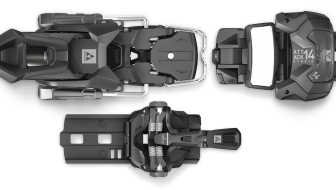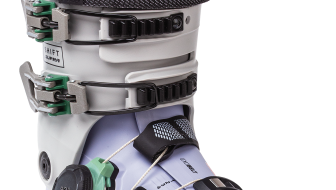For John Fellows, 43, the pursuit of art did not follow a straight path. High school struggles and time abroad in Europe punctuated his journey to find an application for his loves of art and the environment. But the stars aligned for him in Colorado, where he now lives and crafts woodblock prints that reflect his love of the outdoors. We caught up with Fellows to chat about his artistic growth. Here’s what he had to say.

Title: Homage to Crested Butte
Backcountry Magazine: How did you get started as an artist?
John Fellows: Art and the outdoors have always been present in my life, but not something I pursued seriously. I was an army brat and moved every three years growing up, and some of those years were spent in a Volkswagen van with my family driving and camping our way around Europe. This planted the seed for travel and the outdoors in my brain. Growing up, I loved drawing and went to college for graphic design at Drexel University in Philadelphia—I’m originally from the East Coast. My parents moved to Boulder my sophomore year, so I started using any school holiday as an excuse to head “home” and explore Colorado. That gave me the motivation to hike and ski as much as I could while I was there. After I graduated, I started freelancing, which gave me the freedom to travel whenever I had the money for plane tickets.
I went to Europe a lot because it was so cheap from the East Coast back in the day. And I ended up helping out at a little hostel in Gimmelwald, Switzerland. I helped out there for three or so summers. I would clean the kitchen and make beds just for a free place to stay. As soon I was done working, I would run outside and start hiking and scrambling around the Alps. I also got to spend one awesome ski bum winter in the village of Murren, Switzerland, where I was paying $8 a night for a ski-in ski-out place.

A t-shirt design for the Northwest Avalanche Center.
During these trips, I would often travel with small linoleum blocks and would sometimes carve my own postcards from the road or give prints to people I met at the hostel.
At that point, I’d had enough of Philly and when I got back to the U.S., I decided to move to Colorado. And as fate would have it, I met my future wife who was backpacking around Europe and who just happened to be from Colorado. After moving, I ended up working at Keystone Resort for almost five years. I also was running a small sign shop where we would design and build everything from trail signage and bus graphics to t-shirt design. This reminded me how much I loved design, so when we made the move down the hill to Denver, I jumped into the design/art community headfirst and was lucky enough to be offered a small art show at a friend’s shop. The positive reaction to my work blew me away, and I decided I wanted to seriously pursue making art. Life’s ebb and flow can be funny; I gave up design and art for the mountains and then the mountains reminded me that I loved design and art and showed me I could mix both passions.

Title: Mer de Glace
BCM: Tell me about the recreational influence in your art.
JF: The mountains have always inspired my work—my senior thesis was creating and designing a full ski company—but it’s hard not to be inspired by the natural world. I grew up skiing and have been lucky to ski and work in places like the Alps, Argentina, New Zealand and Steamboat and Keystone here in Colorado. The excitement and beauty of these places, from hiking a ridgeline in a foreign country to being holed up in a little ski club hut, started creeping into my work and pushing out other subject matter. Soon most of my work reflected these landscapes, personal travels and adventures.

Title: The View, a Ski Journal cover
BCM: It looks like your subject is dictated by the medium. Tell me about your process.
JF: I was always a control freak when I would draw. If whatever I was drawing didn’t look exactly like what I was looking at, I’d get angry. But once I started getting more into carving, I realized that no matter what the original drawing looked like, the finished carving was going to have its own character. It was a way for me to free myself from being a control freak. My work tends to be very graphic; I use bold lines and solid blocks of color, no shading or gradients at all like in painting. This is a result of using block printing to create my work in addition to having a background in graphic design.
For personal work I’ll sketch in a stream of consciousness—unless there is something I really want to focus on—and eventually something will come out, and I’ll pursue it more. I do pretty much everything by hand, from the initial drawing to the carving to printing the block using a wooden spoon. To make one of my collage style pieces, I print the block onto a variety of old, reclaimed paper. Then I cut every single piece out and take a black marker to all the edges, so when they are re-glued back together you don’t see any separations between the different layers. For the most part, the only color you see in one of these pieces is actually the tone of the paper the block is printed on.

Title: Old Man in the Mountain.
BCM: You use up-cycled materials. Why?
JF: I use antique paper, because I like the aesthetic that it brings to the pieces. The faded look brings an older feeling to the work, which I like because block printing is an older tradition. It is also another way to bring different levels and colors to a black and white piece. I use books from the 1800s, old college theses, vintage scrapbooks, topographic maps and nautical charts—things like that. But it’s also nice to use things instead of having these items go in the garbage.
A lot of times I’ll use old book pages, and depending on the title of the book, viewers will be able to project their own meaning on the piece based on their relationship with the book. It makes it more personal for the people looking at it. I think of my pieces as a glimpse into someone else’s story, but others will see them in two parts: what I created, and the underlying personal meaning. I recently showed a piece in Aspen that had an A-frame on it using an old topo map of Aspen dated to around 1958 for the background, and people kept telling me how excited they were that I’d done a piece about the Tagert Hut. That wasn’t my intention, but I love that people can take this and see something meaningful to them.

Title: Cabin
BCM: What do you like about doing collaborations with other companies?
JF: It’s always nice working with companies when you like and believe in what they do. I’ve been a skier my whole life, and of course the dream for me was to get the chance to design a ski graphic. A few years back I got the opportunity to create the artwork for the 2016 Kufo from Armada Skis. I was stoked, because I had been using their skis for a few years and loved them, so it was a perfect fit for me. I got to do a collage-style piece and it was the largest carving I have done. It was just over three-feet by two-feet. That might not sound that big, but I carve and print everything by hand. I was able to draw on my own experience of living and skiing in the Alps and created a giant piece based on people adventuring into the high alpine world of the Alps. It was a ton of work but still one of my favorite collaborations I have ever done.

Title: End of a Good Day
BCM: How has the collaboration process evolved over the past few years?
JF: It’s nice to finally get calls from people for work. For years I was banging on people’s doors trying to find jobs. Just like anything rewarding, you learn that you have to work hard for what you want. Every year I also make a little book of my work that I send to people who I think would like it. And that’s how I’ve gotten most of the jobs I’ve taken on recently. The book covers the work created over the past year, the creative process and trips that have inspired the work and people have been receptive to that. Especially these days when people are just sending portfolios over the internet yelling, “Look at my work!” I think people have moved back to enjoying something physical they can hold in their hands.
—
To see more of Fellows’s artwork, visit www.instagram.com/jfellows56.










Related posts:
Skintrack Sketches: Artist Jill Pelto documents climate change through watercolor
Skintrack Sketches: Lori LaBissoniere finds her inspiration in the Pacific Northwest's remote landsc…
Skintrack Sketches: Painter Rachel Pohl talks balancing reality and the conceptual in the mountains
Skintrack Sketches: Mimi Kvinge looks to balance authentic artistic identity and brand